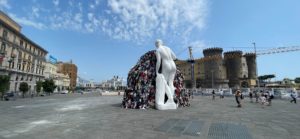A bitter, disorienting, emotionally impactful awakening. This morning Naples did not just wake up to the light of dawn, but to the unexpected flames that destroyed the Venus of the Rags, accompanied by columns of smoke visible from different parts of the city. Michelangelo Pistoletto‘s work, inaugurated on 28 June in Piazza del Municipio, was in fact destroyed by a fire. The fire brigade, alerted by passers-by, arrived promptly, but could not save the work: the flames left nothing behind apart from the metal structure and a few shreds of fibreglass canvas: neither the rags nor the sculpture were spared. The police are working to understand the dynamics of the incident. The Councillor for Security of the City of Naples, former Prefect Antonio De Iesu, told Corriere del Mezzogiorno that it was “a very serious incident and certainly an act of vandalism. The forensic police are viewing the cameras in the hope of finding elements helping with the investigation”.
The inauguration a fortnight ago
The project of the Venus of the Rags was developed as part of Open. Art in the Centre:
in Naples, since June, contemporary art has in fact been at the forefront thanks to the rich programme of exhibitions and installations wanted by the mayor Gaetano Manfredi and curated by Vincenzo Trione, the mayor’s advisor for contemporary art and museum activities. The aim of the project is to strengthen the city’s vocation for contemporary art through a series of initiatives specifically designed for public spaces and museum sites by the protagonists of the art of our time. The work was to be the visual reference point and tangible testimony of the city’s commitment to art and culture. As part of the programme of Napoli contemporanea (contemporary Naples), it represented an open invitation to citizens and visitors to experience the piazza as a place of relationship and daily dialogue.



The Venus of the Rags in Naples
The “Neapolitan” Venus of the Rags, a copy of the original one on monumental scale, had been made by Cittadellarte and designed specifically for Naples. This work had renewed the link Pistoletto had established over the years with Naples, reactivating a reflection on materials and consumption through the dialogue between the rags and the classical statue. The act of dressing and undressing, recalling such an individual and universal gesture, is confronted with a global dilemma: the accumulation of waste, the continuous passing of things, beauty versus pollution. Finally, the Venus of the Rags becomes a sculptoreal metaphor for the contradictory identity of Naples: beauty and ruins, sublime and imperfections, purity and rubble. The intervention – financed by the Metropolitan City of Naples – was part of the urban requalification processinvolving high-profile artists from all over the world and from different generations, active on the territory, called upon to intervene in squares, streets, cloisters, neighbourhoods.
Michelangelo Pistoletto’s comment
“My first thought,” said the artist, “was that I had to control my emotions, because reason must always win. Emotion and reason always coexist and are a duality that must find an agreement, a balance, a harmony. The Venus of the Rags represents precisely this duality: endless beauty and continuous degradation. Two opposing elements that are, perhaps, one more linked to emotion, the other to reason, but they meet to represent the regeneration of the rags that we are producing. It is not only physical debris, but intellectual, moral, social and political debris. Venus represents venerability: the word ‘venerable’ actually comes from her name. It is a moral concept of incredible depth and magnitude, which must regenerate the ragged society that has unfortunately taken over: it is like a self-combustion of the worst act of humanity. I,” concluded Michelangelo Pistoletto, “do not declare preventive war on those who made this catastrophic gesture, I propose preventive peace instead”.
#VenereDegliStracci in fiamme, l’amaro commento dell’autore Michelangelo #Pistoletto pic.twitter.com/cAmQyZSOKk
— Fanpage.it (@fanpage) July 12, 2023
Maria Pioppi Pistoletto’s comment
“Looking at it in a broader dimension, could the destruction of the Venus be defined as a feminicide?” Maria Pioppi wondered.
The mayor of Naples’s comment
“I feel dismay,” said the first citizen Gaetano Manfredi, “for an act that was of great violence and truly leaves all of us bewildered, because when one attacks art and beauty, one attacks man. After the initial shock, however, comes the reaction, the response. We will redo the installation, because the Venus of the Rags is a great symbol of regeneration and represents a new start of society. It cannot therefore be stopped by vandalism and violence. What happened hurts me, but we should not be surprised, because if we look at the history of mankind there has always been a continuous clash between beauty and progress and violence and regression. In the end, however, beauty, progress and civilisation have always prevailed. Naples will react to this act of barbarism, it will do so without giving up, without being afraid of anything. I am a great believer in public art,” he concluded, “because art must be free and accessible. The tens of thousands of people who have photographed the Venus in recent weeks testify to the impact it has also had in the reflection and criticism of citizens and tourists”.
Napoli: distrutta da un incendio alle prime luci di questa mattina, la “Venere degli stracci”, opera d’arte di Michelangelo Pistoletto. L’opera era stata posta a fine giugno in piazza Municipio #Napoli #VeneredegliStracci #Pistoletto #incendio #localteam pic.twitter.com/Ag7jFlEG16
— Local Team (@localteamtv) July 12, 2023
Cittadellarte’s director’s comment
“The Venus of the Rags,” explained Paolo Naldini, “has been the symbol of a world in an age of thoughtless consumerism since 1967; the burnt Venus is now the symbol of the burning planet and of what our violence leads to. We will verify the solidity of the burnt structure. I would also like to say that I am in solidarity with the Neapolitans and their institutional representatives, who welcomed this work in Piazza del Municipio, a public space par excellence: how beautiful and important it would be if the Neapolitans would each bring a rag and assemble together a new public work, the result of everyone’s care for our planet, for the courage of beauty against the intimidation of fear”.
The head of Cittadellarte’s Fashion Office’s comment
“The Venus,” said Olga Pirazzi, “was in Naples to launch a message of hope and draw attention to the issue of sustainable fashion. One of the objectives was in fact to regenerate textile waste, instead, in the light of what has happened, we have gone back in time, like an anachronism, when clothes were burnt in incinerators”.

